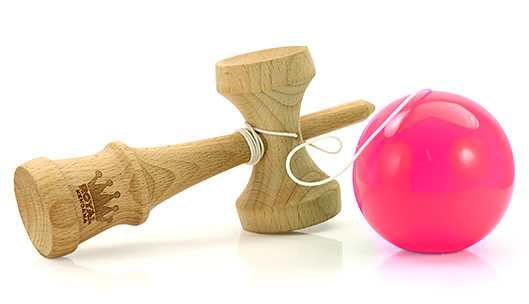I’ve been playing Kendama for over 6 years, and I’ve seen many people getting really hooked into it. As game designer / developer I was curious about it and analysed the game from the game design point of view. Let me share the results.
Let’s get to the basics: kendama is a traditional Japanese skill toy similar to ball and cup, except that it has 3 cups and a spike. This is how a kendama looks like:
The toy itself is several hundreds years old. Not only it is still played today, but its popularity is on the rise and there is a thriving community behind it.
When a game this old survives, it surely has some good game mechanics built in. The ones I found more interesting are onboarding, flow, appeal to player types and metagame.
Onboarding
Kendama is really straight forward to understand. There is a ball with a hole and there is a spike. Everybody gets that (although spike is not the first trick you should learn). Since there are 3 cups as well, people naturally gets into using those and not just the spike.
As players gets more familiar with the kendama, they usually realise of the other rims which you can also use that are not obvious on first sight.
There is an official list of tricks and levels that you can follow as a guided onboarding. These skill levels have been created by the Japanese Kendama Association. You can check the list of tricks and skills in the BKA page.
Most kendamas include some information of the basic tricks, sometimes the skill levels and even some websites with tutorials in the packaging.
While the skill levels are a great way to do your user journey right, they are limited.
The Internet in general and youtube in particular are key factors of the growth Kendama has seen in the recent years.
On one side, there is the amount of video tutorials but on the other side is exploring what is possible beyond the basic tricks by watching edits from players. Once you master the basics, you want new challenges and those are very easy to find online. Just in case, there are over 100 tricks with videos included in KendamApp.
In summary, onboarding for kendama was always easy, but the internet has played a large role in pushing the limits and helping people realise what is possible making the path to mastery easier to discover.
Flow
Flow is a state when the challenge you are trying to achieve is within your reach, but requires some effort. If it is to difficult, it generates anxiety, if too easy, boredom. When the difficulty is right you enter flow, and being in the flow feels great.
It is important to note that to stay on the flow the challenges must adapt to your skill as it improves.
 You can read more about flow in the article: Cognitive Flow: The Psychology of Great Game Design.
You can read more about flow in the article: Cognitive Flow: The Psychology of Great Game Design.
Kendama is really good at getting you in the flow and keeping you in. In this aspect it is not different from most juggling disciplines as it is self-driven and presents a continuous challenge.
Flow is the best way to improve any skill since while your skills improve and you are always presented with a challenge that is within your reach but requires you some effort to master it. Motivation and sense of progression are always there.
Let’s get into the 4 aspects that a game must have to provide flow:
Concrete goals with manageable rules
When you are trying to learn a new trick the goal is very specific. Tricks have very simple descriptions and are easy to understand, even the advanced ones.
There are many simple tricks. As you advance, tricks can be a composition of other tricks or a sequence or a modification, still concrete, still manageable rules.
Only demand actions that fit within a player’s capabilities
It is up to the player to choose the trick to practice. If a trick is too hard, the player can step down and try a simpler version, when a trick becomes too easy you can step up for something harder.
There is always a new trick or a variation that you can try. As it is all player-driven -unless training for a skill level- the risk of getting into the anxiety or boredom zones is very small.
There is a caveat that comes with being player driven: it needs motivation. This is actually solved by the game itself. Hitting a trick gives a dopamine high and the sense of progression helps making it addictive. On top of that, there is some exercise, so there are endorphins as well.
As we already covered on the onboarding section, there are hundreds of tricks, providing an almost unlimited challenge.
There are also different types of tricks so you can choose based on your preferences, aerial, string, balance, etc.
Clear and timely feedback on player performance
When you try a trick you either hit or you miss, the feedback is instantaneous and extremely clear (as happens with most real world games).
There are some important effects in the way you practice kendama too:
- Each try is very quick.
- It is easy to try again.
- There is low impact of failure.
- Anticipation of success: When you see the kendama getting right into place your brain anticipates the possibility of success and generates dopamine. This happens before the outcome is determined, so you get it even if you miss.
- It is based on intrinsic motivation: you want to land the trick.
Remove any extraneous information that inhibits concentration
This is meant mainly for video games, but you’ll be surprised how much focus you can get when playing kendama for a trick you haven’t managed yet.
Types of Players
Bartle taxonomy of player types is a well known classification of the different player types and I think kendama appeals to all of them.
This classification is generally used to determine how a game is targeted to a certain type of players regarding how the interact with the game and with other players.
Achievers
These are players who prefer to gain “points”, levels, equipment and other concrete measurements of succeeding in a game.
For these players, the skill levels is a great fit. You have a level that you can improve and when you do so in front of an examiner, you get a diploma. You start from 10 Kyu to 1 Kyu (beginner levels) and then from 1st Dan up to 6th Dan.
Dave Mateo is a good example of a player of this type. He keeps pushing himself to add more spins on the tricks, like a 11-turn jumping stick.
The main difference with killers is that killer want to beat other players while achievers battle themselves to improve.
Explorers
Explorers prefer discovering areas, creating maps and learning about hidden places.
When it comes to kendama, explorers naturally go into freestyle, trying new combinations of tricks and pushing towards finding their own personal style, many times inventing new tricks.
Iijima Hiroki is an explorer, he went on and created his own style. You can learn more about him on: Portrait of a Kendama Samurai.
Socializers
There are a multitude of gamers who choose to play games for the social aspect, rather than the actual game itself. They gain the most enjoyment from a game by interacting with other players.
The kendama community is quite large and attending real life events usually means meeting other players in person whom you have only interacted with online. There is a lot of people that go to those just to be with other players, no need to even do a trick.
Jake Wiens is a socializer. He runs a weekly meetup in San Francisco just to meet people and expand the kendama love.
Killers
They thrive on competition with other players.
While this is the least common part of kendama, there are competitions like the Japanese Kendama Open, Kendama World Cup, European Kendama Open, and many more where you can compete against very good players and win prizes.
In addition to that, there are small competitive games that you can play on a group.
A good example of a killer is Tomoya Mukai. He is at his best when competing on stage.
Metagame
Kendama is not just about doing tricks. There are other aspects of it that also appeal to players.
- Collecting: There are many kendama brands, some of them are discontinued and considered collector pieces. Players start getting more and more kendamas to try the differnet brands and before you know, you have started a collection.
- Customizing: There is a large community of people that paint/tune their own kendamas to make them special, some of them sell them afterwards.
- Modding: A kendama is composed of 3 parts, each one of them has a weight. How the weight is distributed impacts how a kendama plays. Some players mix and match several kendamas until they have one with the perfect distribution for their taste.
Putting all this into place, I’d say kendama fits very well into modern game design and it is only logical that its popularity has been on the rise and that players get hooked easily.


